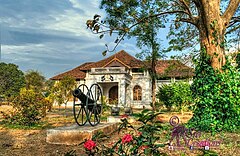Shakthan Thampuran Palace
| Shakthan Thampuran Palace | |
|---|---|

Facade of Shakthan Thampuran Palace, City of Thrissur
|
|
| General information | |
| Architectural style | Kerala-Dutch style |
| Town or city | City of Thrissur |
| Country | India |
| Completed | 1795 |
| Client | Sakthan Thampuran, Maharaja of Cochin |
| Technical details | |
| Structural system | Kerala style of Nālukettu |
Shakthan Thampuran Palace is situated in City of Thrissur in Kerala state, India. It is named as Vadakkekara Palace, was reconstructed in Kerala-Dutch style in 1795 by Ramavarma Thampuran of the erstwhile Princely State of Cochin, well as Sakthan Thampuran (Greatest ruler of the Cochin dynasty) is preserved by Archaeological Department. The palace was converted into a museum in 2005 by State.
The main structure of the Sakthan Thampuran Palace has a two-storeyed building and a traditional Kerala style Nālukettu. High roofs, extra thick walls, spacious rooms and floors paved with finely smoothened Italian marbles are some of the structural specialities of this palace. The interiors of the palace, because of its unique construction offer comfortable and pleasant staying conditions irrespective of the prevailing weather conditions.
Sakthan Thampuran Palace once belonged to the Perumpadappu Swaroopam, the ruling dynasty of Kochi. This was the centre of power of King Rama Varma Sakthan Thampuran, who ruled Kochi between AD 1790 and 1805. His rule was regarded as the Golden Era of the Cochin dynasty. The palace is close to the Vadakkumnathan Temple in Thrissur. Saktan Thampuran is credited with the introduction of the Thrissur Pooram festival, an annual festival in May with teams representing the Parmekavu Bhagavathy temple and Tiruvambadi Krishna temple competing for primacy in front of the Vadakkumnathan temple with elephants, percussion, drums, fireworks, etc. The palace was once known as Vadakkechira Kovilakam and it was the king who renovated it into the present form. The palace keeps with it the historical remnants of some important events like the visit of Tipu Sultan with his army. The last member of the royal family to reside here was Rama Varma Bharathan Thampuran, a grand nephew of Chowwarayil Theepetta Veliyathampuran. The palace has a very old Sarpakavu (sacred serpent grove) in its premises.
The museum displays Bronze Gallery where one can find bronze statues belonging to the period between the 12th and the 18th centuries, Sculpture gallery displaying granite statues from the 9th century to the 17th century, Numismatics Gallery, which systematically displays ancient coins, which were in circulation in the former province of Kochi and neighbouring kingdoms and the history gallery depicting some of the milestones of the Kochi dynasty and the Epigraphy Gallery showcasing the genesis and evolution of ancient writings. Other galleries of interest at the palace include, a Gallery for Household Utensils made of bronze and copper, used by the rulers of Kochi; and a Megalithic Gallery exhibiting remains of the great stone age.
...
Wikipedia
